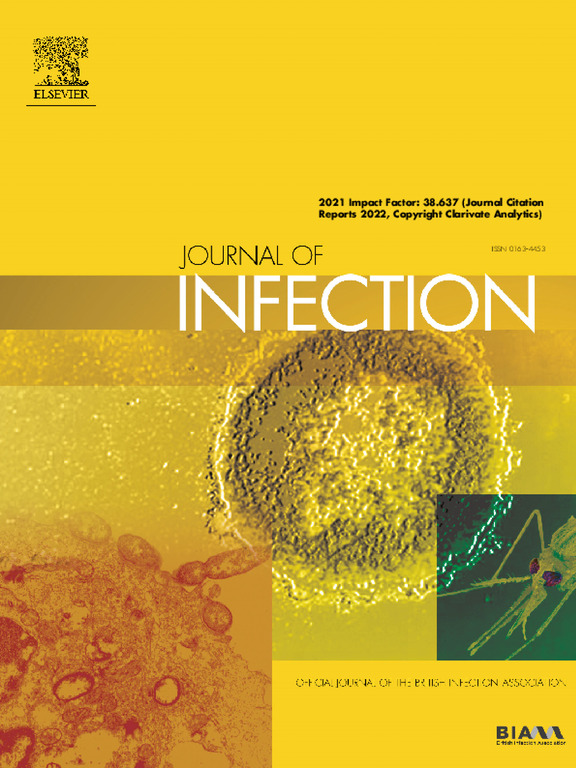不同的鼻咽微生物群模式:肺炎球菌性肺炎、COVID-19和健康成人的比较研究
IF 11.9
1区 医学
Q1 INFECTIOUS DISEASES
引用次数: 0
摘要
下呼吸道感染(LRIs)是世界范围内导致死亡的主要原因之一。许多导致LRIs的微生物,如肺炎链球菌和呼吸道病毒,表现出不同的行为:它们可以作为无症状的定植菌存在,引起轻度疾病,或导致严重的侵袭性感染。多种因素影响LRIs的临床表现和严重程度。新出现的证据表明,鼻咽微生物群(NM)在这些过程中起着至关重要的作用。本研究旨在确定与呼吸系统健康和疾病相关的微生物群概况。方法:于2021年2月至2022年9月进行前瞻性病例对照研究。NM样本采集自肺炎球菌肺炎(PPn)、COVID-19肺炎(CPn)和健康对照(HC)的成人。采用16S rRNA基因测序对样品进行分析。参与者根据年龄和性别进行匹配。随机森林模型应用于微生物群数据,以区分肺炎球菌肺炎和病毒性社区获得性肺炎(CAP)。结果:共分析129份样本,其中PPn 38例,CPn 54例,HC 37例。虽然各组的年龄和性别分布相似,但合并症、免疫抑制和既往感染在病例中更为常见。α -多样性分析显示,不同类群间物种丰富度和均匀度均无显著差异。然而,β -多样性分析显示不同的微生物组成:棒状杆菌在CPn患者中占优势,而链球菌在PPn患者中比HC更丰富。结论:成人肺炎球菌肺炎患者的鼻咽菌群与COVID-19肺炎患者和健康对照组存在显著差异。这些发现表明,在从无症状定植到疾病的进展中,特定细菌属的重要性。更深入地了解健康的鼻咽微生物群概况可能对预防和治疗呼吸道感染具有重大意义。本文章由计算机程序翻译,如有差异,请以英文原文为准。
Differential nasopharyngeal microbiota patterns: A comparative study of pneumococcal pneumonia, COVID-19, and healthy adults
Introduction
Lower respiratory infections (LRIs) rank among the leading causes of mortality worldwide. Many microorganisms responsible for LRIs, such as Streptococcus pneumoniae and respiratory viruses, exhibit variable behavior: they can exist as asymptomatic colonizers, cause mild disease, or lead to severe invasive infections. Various factors influence the clinical manifestations and severity of LRIs. Emerging evidence suggests that the nasopharyngeal microbiota (NM) plays a crucial role in these processes. This study aims to identify microbiota profiles associated with respiratory health and disease.
Methods
A prospective case-control study was conducted between February 2021 and September 2022. NM samples were collected from adults with pneumococcal pneumonia (PPn), COVID-19 pneumonia (CPn), and healthy controls (HC). Samples were analyzed using 16S rRNA gene sequencing. Participants were matched for age and gender. Random Forest modeling was applied to microbiota data to distinguish pneumococcal pneumonia from viral community-acquired pneumonia (CAP).
Results
A total of 129 samples were analyzed, including 38 from PPn cases, 54 from CPn cases, and 37 from HC. While age and sex distributions were similar across groups, comorbidities, immunosuppression, and prior infections were more common among cases. Alpha-diversity analysis revealed no significant differences in species richness or evenness across groups. However, beta-diversity analysis showed distinct microbial compositions: Corynebacterium was predominant in CPn patients, whereas Streptococcus was more abundant in PPn patients compared to HC.
Conclusions
The nasopharyngeal microbiota differs significantly in adults with pneumococcal pneumonia compared to those with COVID-19 pneumonia and healthy controls. These associations highlight the potential relevance of specific bacterial genera in disease susceptibility. A deeper understanding of healthy nasopharyngeal microbiota profiles could contribute to future strategies for the prevention and management of respiratory infections.
求助全文
通过发布文献求助,成功后即可免费获取论文全文。
去求助
来源期刊

Journal of Infection
医学-传染病学
CiteScore
45.90
自引率
3.20%
发文量
475
审稿时长
16 days
期刊介绍:
The Journal of Infection publishes original papers on all aspects of infection - clinical, microbiological and epidemiological. The Journal seeks to bring together knowledge from all specialties involved in infection research and clinical practice, and present the best work in the ever-changing field of infection.
Each issue brings you Editorials that describe current or controversial topics of interest, high quality Reviews to keep you in touch with the latest developments in specific fields of interest, an Epidemiology section reporting studies in the hospital and the general community, and a lively correspondence section.
 求助内容:
求助内容: 应助结果提醒方式:
应助结果提醒方式:


